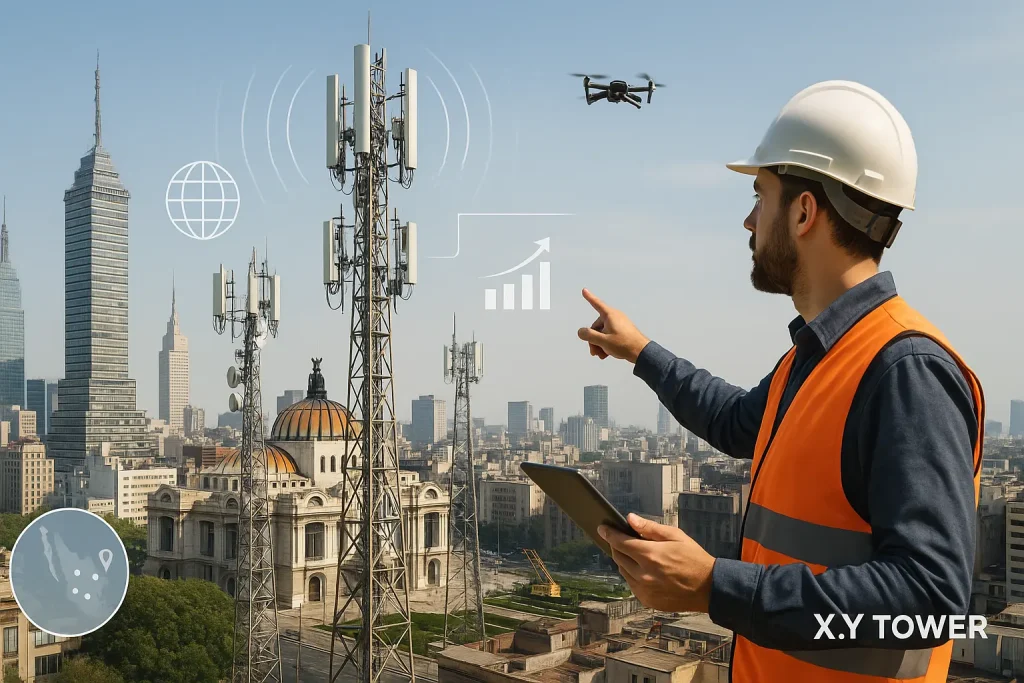Find Communication Towers in Mexico City
2025-09-25
Finding a communication tower in Mexico City is a foundational step for network deployment. Mexico City is one of the largest metropolitan areas in the world. Its immense population and economic importance create a massive demand for connectivity. The city’s unique urban and geological characteristics present significant challenges. Mobile network operators and infrastructure companies require highly skilled partners. These partners must deliver sophisticated engineering and resilient structures. A leading supplier understands the complexities of this megacity. They provide the essential infrastructure for robust 4G and expanding 5G networks. This guide explores the key aspects of the city’s tower market.

The Immense Demand for Connectivity in a Megacity
The primary driver for a communication tower in Mexico City is its sheer scale. The metropolitan area is home to over 22 million people. This incredible density of users creates an insatiable demand for mobile data. Every aspect of modern urban life, from commerce to social interaction, depends on reliable connectivity. This constant demand fuels a continuous cycle of network investment. Understanding the sources of this demand is key to understanding the infrastructure market. It explains why the city is a focal point for telecom development.
Connecting a Massive, Concentrated Population
The enormous population of Mexico City creates a baseline of demand unlike most other places. Millions of people use their mobile devices simultaneously. This puts enormous strain on network capacity. A dense grid of communication towers is necessary to handle this traffic. Operators must constantly add new sites to avoid congestion and maintain service quality. This need for densification is the most fundamental driver for every communication tower in Mexico City. It is a constant challenge to keep up with the population’s needs.
Powering a Major Economic and Financial Hub
Mexico City is the economic engine of the country. It is a major financial and corporate hub for Latin America. Businesses of all sizes depend on high-speed, reliable mobile connectivity. This is essential for digital transactions, logistics, and daily operations. The quality of the telecom infrastructure has a direct impact on economic productivity. A reliable communication tower in Mexico City supports this vibrant business ecosystem. It ensures that the city remains a competitive place to do business.
The Push for Smart City Initiatives
Like many other global megacities, Mexico City is embracing smart city technologies. These initiatives aim to improve urban services, transportation, and public safety. They rely on a network of IoT sensors and connected devices. This requires a pervasive and powerful 5G network. A communication tower in Mexico City is a key enabler of these smart city goals. The infrastructure supports the massive data flows generated by these new technologies. This is a significant future growth driver for the market.
Unique Challenges of Tower Deployment in Mexico City
Deploying a communication tower in Mexico City involves a unique and formidable set of challenges. The city’s geology, history, and urban density create a complex operational environment. A successful infrastructure provider must have specialized expertise to navigate these issues. These challenges affect everything from the engineering design of a tower to the process of securing a permit. Overcoming these hurdles is the defining characteristic of a top-tier provider in this market.
Engineering for a Seismically Active Zone
Mexico City is situated in a highly active seismic zone. Earthquakes are a significant and recurring threat. Furthermore, the city is built on a former lakebed. The soft soil can amplify seismic waves, making structures more vulnerable. A communication tower in Mexico City must be engineered to the highest seismic standards. This requires advanced structural analysis and specialized foundation designs. Ensuring the resilience of towers during an earthquake is the most critical engineering consideration. This is a challenge shared with other seismically active locations like the market for a communication tower Chile.
Complex Site Acquisition and Permitting
Finding a location for a new communication tower in Mexico City is extremely difficult. The city is densely built, with limited open space. The process of acquiring a site and obtaining all the necessary permits is notoriously complex. It involves navigating multiple layers of federal and municipal bureaucracy. A leading provider has a dedicated team of experts. They manage this process of site acquisition and permitting. This expertise is vital for avoiding long delays and ensuring projects can move forward.
Aesthetic and Zoning Regulations
Mexico City has a rich cultural and architectural heritage. There are strict zoning regulations, especially in historic districts. These rules are designed to preserve the city’s character. A communication tower in Mexico City must often be designed to be visually unobtrusive. This has led to a high demand for stealth and camouflaged solutions. Providers must offer a range of aesthetic designs to meet these requirements. This includes monopoles, rooftop solutions, and structures disguised as other urban features.
Ensuring the Security of Infrastructure Assets
As in any large urban area, ensuring the security of tower sites is an important consideration. Remote or less-monitored sites can be targets for vandalism or theft of equipment. A reliable provider must incorporate robust security features into their site designs. This includes secure enclosures, anti-climb devices, and options for remote surveillance. Protecting the valuable equipment on a communication tower in Mexico City is essential for maintaining network reliability.
The Structure of the Mexico City Tower Market
The market for a communication tower in Mexico City is well-established and highly structured. It is dominated by a few large infrastructure owners. These companies work with a competitive field of mobile network operators. This structure creates a dynamic and sophisticated market. Understanding the roles of the different players is key to understanding the industry. It explains how new towers are financed, built, and operated in this complex urban environment.
The Dominant Role of Large Towercos
The tower market in Mexico City is led by large, independent tower companies. These towercos own and operate the vast majority of the city's telecom infrastructure. They have extensive portfolios of towers that they lease to multiple operators. This shared infrastructure model is highly efficient. It is the standard for the industry. These towercos are the primary clients for any company that manufactures or installs a communication tower in Mexico City. Their investment strategies shape the entire market. This model is common across the region, making cell tower installation Latin America a specialized field.
The Competitive MNO Landscape
Mexico City is a key battleground for the country's major mobile network operators (MNOs). Companies like Telcel (América Móvil), AT&T, and Movistar compete fiercely for customers. Their need to provide the best possible network coverage and capacity drives the demand for new tower sites. The network expansion plans of these MNOs determine where and when new infrastructure is needed. A company providing a communication tower in Mexico City must be responsive to the needs of these large operators.
The Ecosystem of Suppliers and Partners
A wide range of companies supports the tower market. This includes international manufacturers who supply the steel towers and antennas. It also includes a network of local service partners. These local companies provide essential services like site acquisition, civil works, and maintenance. A successful project requires a seamless collaboration between these different players. A leading provider of a communication tower in Mexico City often manages this entire ecosystem of partners. This integrated approach is also vital in other megacities, a lesson learned by any top telecom tower supplier São Paulo.
The Growing Importance of Small Cells and DAS
In a dense city like Mexico City, traditional towers alone cannot provide sufficient capacity. Small cells and Distributed Antenna Systems (DAS) are becoming increasingly important. These are smaller, lower-power antennas that are deployed closer to users. They are often installed on street furniture, building facades, or inside large venues. A comprehensive provider of a communication tower in Mexico City will also have expertise in deploying these densification solutions.
Technological Advancements Shaping the Future
The technology used for a communication tower in Mexico City is constantly advancing. Innovation is driven by the need to meet the city’s immense capacity demands. It is also driven by the need to overcome the city’s unique challenges. A leading provider must be an innovator. They need to offer solutions that are resilient, efficient, and aesthetically pleasing. These technological trends are defining the next generation of telecom infrastructure in the city.
The Ongoing 5G Rollout
The rollout of 5G is a major technological driver. 5G requires a denser network and towers that can support new, heavier antennas. A provider of a communication tower in Mexico City must offer structures that are 5G-ready. This includes designing new towers with higher load capacities. It also involves reinforcing existing towers to handle the new equipment. The 5G transition will fuel infrastructure investment for many years. This same transition is a major factor in the market for a telecom tower Colombia.
Aesthetically Pleasing and Camouflaged Solutions
As the network becomes denser, the need for visually unobtrusive solutions grows. There is a high demand for stealth towers. A leading provider of a communication tower in Mexico City offers a wide range of aesthetic options. This allows towers to be deployed in sensitive areas without disrupting the urban landscape. Common urban tower solutions include:
- Slim-Profile Monopoles: Single poles with a small footprint and internal antennas.
- Rooftop Concealments: Structures on buildings that are hidden behind architectural screens.
- Street Furniture Integration: Small cells integrated into bus shelters, kiosks, or streetlights.
- Custom Camouflage: Towers disguised as trees, flagpoles, or other common urban objects.
Advancements in Seismic Engineering
Given the city's seismic risk, there is continuous innovation in structural engineering. New materials and design techniques are being developed. These make towers even more resilient to earthquakes. A top provider of a communication tower in Mexico City invests in this research. They use the latest engineering standards to ensure their structures are as safe as possible. This commitment to safety is a critical part of their value. The engineering challenges are similar to those for a communication tower Peru.
The Use of Remote Monitoring and Management
Managing thousands of sites in a city as large as Mexico City is a complex task. Technology is making this more efficient. Remote monitoring systems allow towercos to track the performance of each communication tower in Mexico City. They can monitor power, security, and equipment status from a central location. This reduces the need for physical site visits. It allows for faster responses to any issues. This efficiency is crucial for maintaining a high level of network reliability.
Conclusion
The market for a communication tower in Mexico City is one of the most challenging and dynamic in the world. It is defined by the incredible scale of the city and its population. It is shaped by unique geological and urban challenges. The market is driven by intense competition between major operators and the rollout of 5G. A successful provider in this environment must be an expert in seismic engineering, urban logistics, and regulatory navigation. The future promises continued demand for more sophisticated, resilient, and aesthetically integrated infrastructure. The right provider of a communication tower in Mexico City is a vital partner in keeping this great megacity connected. The list of mobile network operators will continue to rely on these specialized infrastructure partners.

Hey, I’m Chunjian Shu
"X.Y. Tower: Reliable, innovative solutions for high-quality towers and electrical equipment with professional service.
